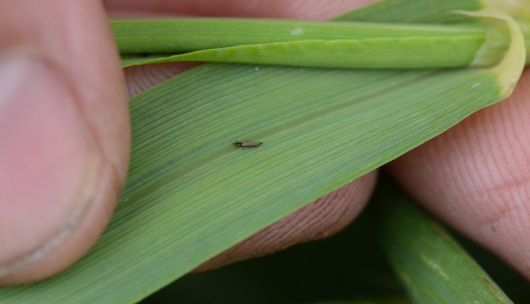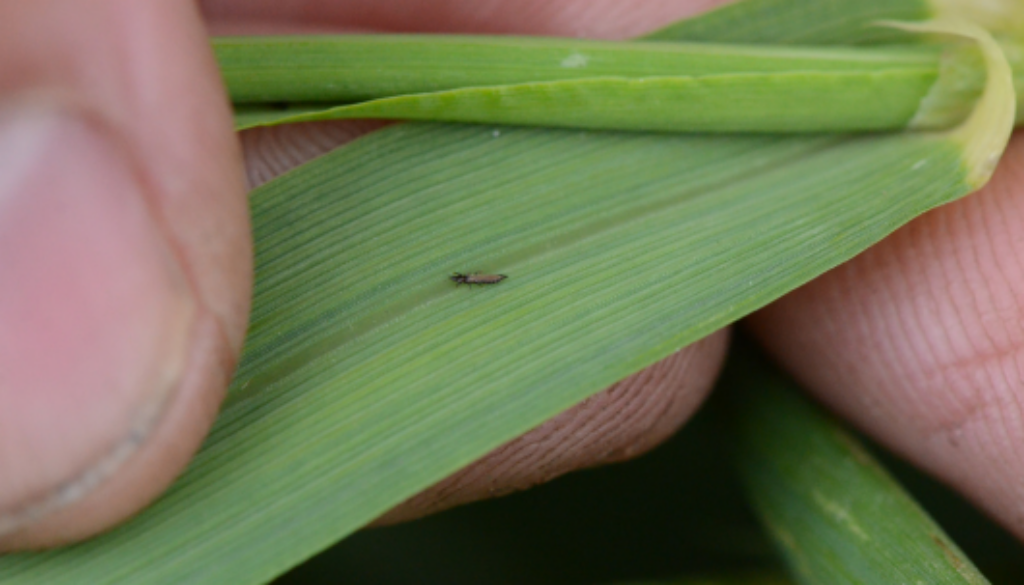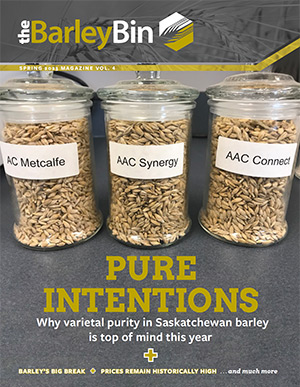The Trouble with Thrips: How to Identify and Manage This Cereal Pest
by Dr. James Tansey Saskatchewan Ministry of Agriculture
There are about 6,000 species of thrips worldwide, with 147 described species in two suborders in Canada, including 28 non-natives. Recent molecular work indicates there may be as many as 255 additional as of-yet-undescribed species in Canada. Although some species are important for pollination and a few are predators of other small insects, thrips can be damaging pests in crops.
They have unique, asymmetrical mouthparts that are characterized by a greatly reduced right mandible. Their feeding is described as “rasping-sucking,” as they scrape the surface of plant tissue and ingest the fluid that flows from the wound. When they feed on actively growing plant tissue, reduced and distorted growth, and yield loss can occur. When they feed on more mature tissue, silver leaf scars can occur that reduce the quality and marketability of some crops.
Thrips, primarily western flower thrips (Frankliniella occidenttalis), melon thrips (Thrips palmi), and chili thrips (Scirtothrips dorsalis), are also increasingly important vectors of tospoviruses worldwide. These infect primarily fruit and ornamental crops.

An Overview of Thrips
Thrips (the same term is used for both singular and plural references) are characterized by small sized (the largest species is only 2 mm as adults, the smallest is 0.6 mm), long slender bodies and fringed wings. Adult thrips are generally relatively weak flyers and employ a “clap and fling” technique. The animal claps the leading edges of its wings together at the end of the upstroke and then rotates the wings around the trailing edges, flinging them apart. Many small insects use this technique to promote air circulation and generate lift quickly.
The barley thrips (Limothrips denticornis) was first reported in North America in 1923 in New York. In its native Europe and Asia, it can be found on a wide variety of grass species but is a minor pest and only on rye. In North America, it is generally more important on barley, though it can be found on winter wheat, durum, winter rye, corn and triticale as well. Adults are small (1.1 mm to 1.8 mm), elongate, and dark brown to black. These thrips lay eggs on upper leaf sheaths and each female can produce 100 eggs. Juveniles are smaller and lighter coloured.
Barley thrips overwinter as adults and move to winter grasses in the spring. They are somewhat stronger flyers than many thrips’ species but are still limited by their size.

Scouting for Thrips in Barley
Thrips feeding on cereals can result in tissues appearing bleached. When numbers are high and feeding is intense, kernels can be shriveled. Severe flag leaf feeding can result in kernels filling improperly and reduced kernel weight.
Scouting for barley thrips should be done from the first sign of flag leaf until the head has completely emerged from the boot. Barley thrips can be found on stems but are more commonly under the top two leaf sheaths. Because thrips are relatively weak flyers, there may be greater concentrations in protected field edges. The greatest damage has been reported in dryland cropping areas after prolonged drought.
The Economic Threshold of Thrips
Threshold (thrips/stem) = (Cost of control per acre/ expected $ value per bushel) / 0.4
Sample at least 50 stems from different parts of the field. One adult thrips per stem can cause a loss of 0.4 bushels per acre. This usually translates to an action threshold for barley and oats of 7-8 thrips/stem prior to head emergence, but greater precision can be achieved by using the formula. The action threshold is the number of insects detected that justify the expense and effort of applying control. Numbers lower than this do not warrant control but may need further monitoring to assess possible population growth. Only apply control prior to the completion of heading.
Thresholds for cereal thrips have been determined for barley and oats, but effects on other cereals crops in North America are less well understood. Work in Europe has found comparable damage from thrips in rye, triticale and winter barley. Recent reports of barley thrips in durum in Saskatchewan also suggest a risk of damaging effects, but these are not as well understood. A report from Germany indicated that, despite some relatively high thrips numbers, there was no correlation between barley thrips and damage. However, there is also evidence from Europe of the importance of long crop rotation to thrips damage control in wheat.
Please forward reports of thrips issues to Dr. James Tansey with the Ministry of Agriculture ((james.tansey@gov.sk.ca)
Read the latest update on thrips from Dr. Tansey here:
Thrips in Saskatchewan Small Grains Cereal Crops | Crop Production News 2024 – Issue #4 | Government of Saskatchewan
This article first appeared in the Spring-Summer 2022 Issue of the BarleyBin Magazine.
Explore More Pest Management Resources

Post-Harvest Guide: Essential Fall Management Strategies for Your Farm
Prepare for a successful next season by addressing fall management tasks like nutrient management, weed control, insect pressure, and residue management. Learn the best practices for soil testing, fertilizer application, and pest management.

The Trouble with Thrips: How to Identify and Manage This Cereal Pest
Dr. James Tansey of the Saskatchewan Ministry of Agriculture outlines all you need to know about scouting and calculating the economic damage caused by thrips in barley.

Lambda Cyhalothrin (Matador®, Silencer®, etc.) Update
In 2023, the Pest Management Regulatory Agency (PMRA) ruled that lambda cyhalothrin (trade names include Matador®, Silencer®, etc.) uses must be restricted. PMRA is the division of Health Canada responsible for reviewing safety data for pesticides.








